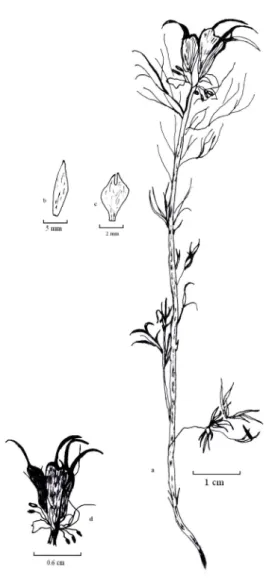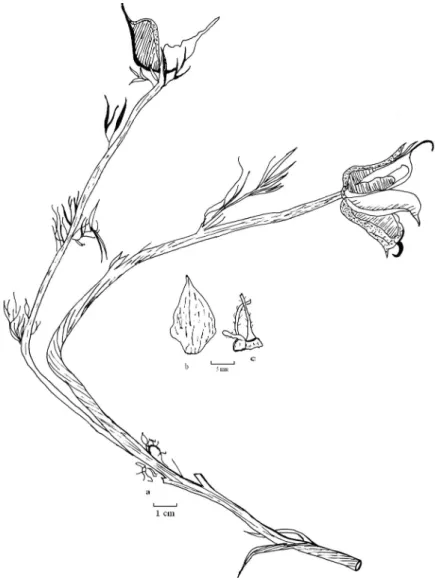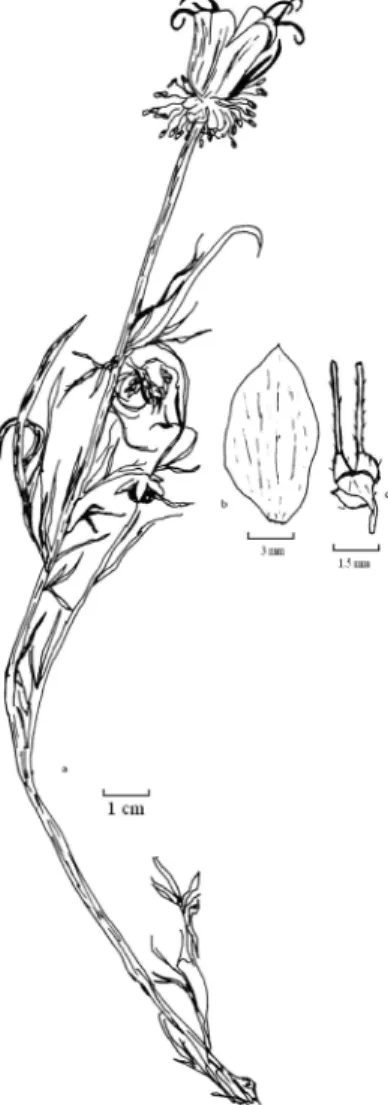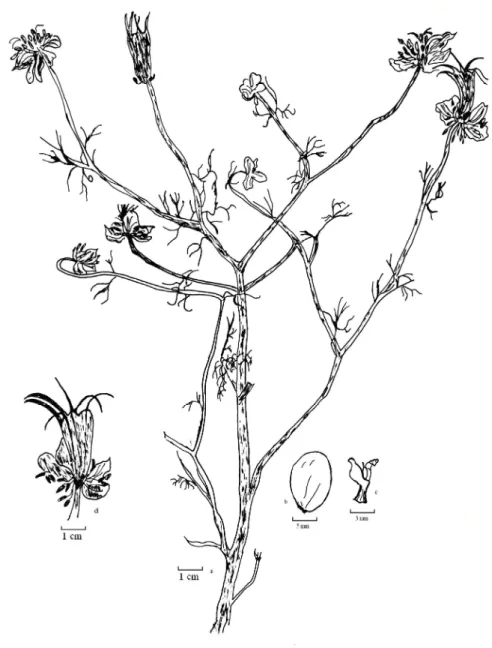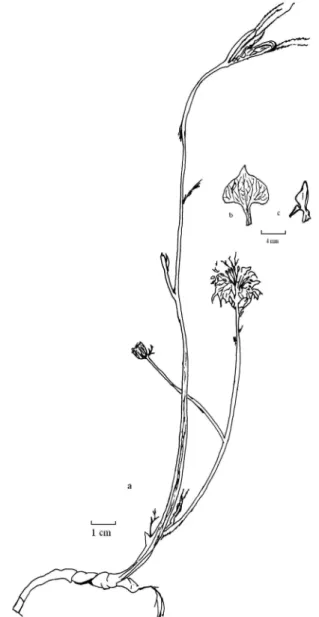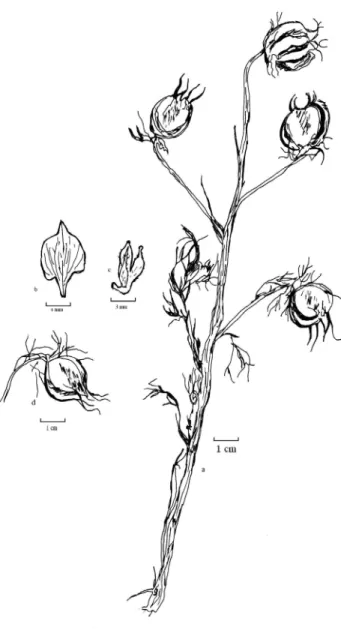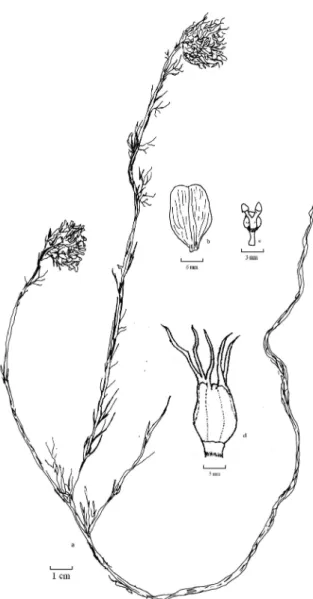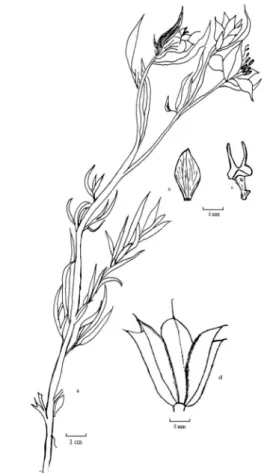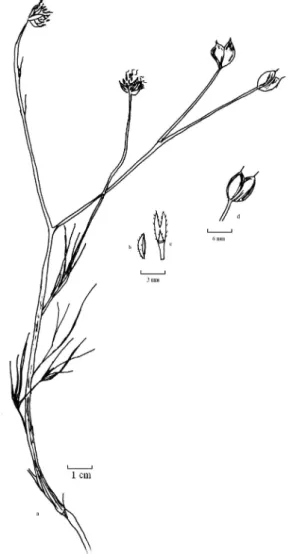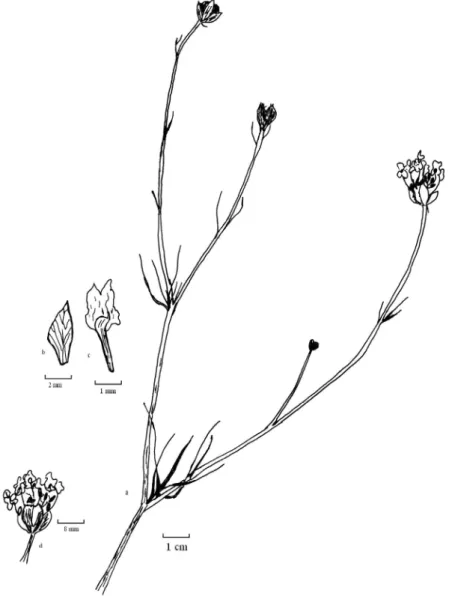MORPHOLOGY AND STEM ANATOMY OF SOME SPECİES OF GENUS
NİGELLA L. İN TURKEY
TÜRKİYE’DEKİ BAZI NİGELLA TÜRLERİNİN MORFOLOJİ VE GÖVDE
ANATOMİLERİ
Gamze KÖKDİL1, Ahmet İLÇİM2, Başak ÖZBİLGİN3, Cihangir UYGUN4
1-3 MEÜ Eczacılık Fakültesi, Eczacılık Meslek Bilimleri Bölümü, Yenişehir Kampüsü – Mersin, TÜRKİYE
2-4 KSÜ Fen Edebiyat Fakültesi Biyoloji Bölümü K.Maraş, TÜRKİYE
ABSTRACT
No previous detailed botanical study exist on Nigella L.species growing in Turkey. The aim of this study was to provide information on the morphological and anatomical properties of ten Nigella L. species (N.orientalis L., N.oxypetala Boiss., N. latisecta P.H. Davis, N.segetalis Bieb., N.arvensis L., N.damascena L., N.elata Boiss., N.nigellastrum (L.) Willk., N. unguicularis (Lam.) Spenner and N.lancifolia Hub.-Mor.). In general; the results obtained from morphological studies were consistent with the description given in the Flora of Turkey.
In the morphological study, it was observed that the herbaceous stems are glabrescent or gloucose in the most of species. Leaves are pinnatipartid or pinnatisect and Inflorescence has various characters. In anatomical studies, the internal morphological features of the stems were determined.
Key Words: Nigella species, Ranunculaceae; morphology, Anatomy ÖZET
Türkiye’de yetişen Nigella türleri üzerinde yapılmış herhangi bir detaylı botanik araştırma bulunmamaktadır. Bu çalışmanın amacı Türkiye’de yetişen on Nigella türünün (N.orientalis L., N.oxypetala L., N. latisecta P.H. Davis, N.segetalis Bieb., N.arvensis L., N.damascena L., N.elata Boiss., N.nigellastrum (L.) Willk., N. unguicularis (Lam.) Spenner and N.lancifolia Hub.-Mor.) morfolojik ve anatomik özelliklerini belirlemektir. Morfolojik çalışmalardan elde edilen sonuçların Flora of Turkey adlı eserle uyumlu olduğu gözlenmiştir. Morfolojik çalışmada türlerin tek yıllık oldukları, otsu gövdelerin çoğunlukla tüysüz veya hafif
tüylü olduğu, yaprakların parçalı, çiçek durumlarının da değişken olduğu belirlendi. Anatomik incelemelerde gövdelerin iç morfolojik özellikleri tespit edilmiştir.
Anahtar kelimeler: Nigella türleri; Ranunculaceae; Morfoloji, Anatomi
Introduction
The genus Nigella L. (Ranunculaceae) includes about 20 species distributed from the Mediterranean regions to West Asia (1). It includes some important species (e.g. N.sativa L.,
N.damascena L. and N. arvensis L.) with aromatic and medicinal properties. N.sativa, a spicy plant,
is cultivated in various parts of the world. The seeds, also known as black cumin or black caraway, have been use in many Middle Eastern, and Far Eastern Countries as a natural remedy for over 2000 years. The seeds or its oil is believed to have carminative, diuretic, lactagoge and vermifuge (2). Recent pharmacological investigations of the seed extract reveal a wide spectrum of activities including antibacterial, antihelminthic, anti-inflammatory, analgesic, hypoglycemic, smooth muscles relaxant and immunostimulant. Some of these activities have been predominantly attributed to the essential and fixed oils (2, 3).
The genus Nigella comprises about 13 species in Turkey (4, 5). One of them is N.sativa and known with the local name as “Çörekotu”. The seeds are used as seasoning for foodstuffs like bread and pickles among Turkish people (6). In the literature, only two species of Nigella growing in Turkey (N.sativa and N.damascena) have been investigated (7-11). Effects of N.sativa seeds originating from Turkish sources have also been evaluated in animal studies (12, 13). Whereas
Nigella species have been extensively investigated phytochemically and pharmacologically, the
studies on the morphology and anatomy of this genus are limited. Therefore, the purpose of this paper is to investigate the morphological and anatomical properties of Nigella L.species growing in Turkey.
Materials and Methods
The specimens were collected during flowering and seed period. Herbarium samples were prepared and deposited at the Ankara University Faculty of Pharmacy Herbarium (AEF). Herbarium and fresh samples were used for morphological features and biometric measurements. A part of the material was deposited in 70% alcohol for anatomical studies. Anatomical investigations were performed on crosssections of the stems. The cross and surface sections were covered with glycerin-gelatine (Vardar, 1987). Photographs of the samples were taken using a Nikon Optiphot.
The taxonomic description of the plants were made according to Davis ( 1978) and new characters were newly added. And also confirmed by the herbarium samples examined in the GAZI and KSUH herbaria.
Morphlogical Results 1- N. orientalis
Plant glabrescent, 10-90 cm, steme erect sparsely branched canaliculate. Leaves pinnatisect, the laciniae linear 0,4 - 0,5 mm lateral segments 5-18 mm, terminal segments 0,5 mm 19-22 mm. Flowers not involucrate. Sepals yellowish to yellowish-brown, ovate base gradually attenuate into short claw, apex sometimes bifid acuminate. 8-9 x 2,5-3 mm, Petals bifid 4-6 mm. folicules compressed, oblong, 2-14, smooth united at least to the middle, weakly divergent, usually slightly longer than styles. Seeds discoid 5,5-6 x 4,5-5,8 mm yellowish brown. Fl. 4-5. Segetal and ruderal habitats. s.1-1280 m.
Examined material: C6 Maraş: Çağlayancerit, Başdervişli village, ruderal fields, 1280 m, 14.06.2002, 8.07.2002, A.İlcim & G.Kökdil, AEF 23131, A.ilcim 1242 KSUH
2- N. oxpetala
Plant glabrescent, 15 - 50 cm, stems erect sparsely branched at above slightly canaliculate. Leaves pinnatisect, the laciniae linear 0,1 - 2 mm. lateral and terminal segments similar 0.1-0.5x 10-35 mm (median leaves with 25-70 laciniae). Flowers loosely involucrate. Sepals greenish-yellow, oblong to ovate scarcely clawed. 15-17x7-9 mm. Lower lip of petals with each lobe produced into a long, filiform, pilose appendage. Folicules 2-12 compressed, oblong, with 3 abaxial nerves, smooth United at least to the middle, scarcely divergent, usually 1.5-2 x the styles. Seeds discoid 6-6.5 x 4-4.5 mm yellowish brown. Fl. 5-7. Rocky slopes, fallow fields, 900 -1200 m.
Examined material: B7 Malatya: around Inonü University Campus, fallow fields, 1500 m, 28.06.2002, 08.06.2003, G.Kökdil & D.Kara, AEF 23130, A. ilcim 1212 KSUH
3- N. latisecta
Plant glabrescent, 25 - 35 cm, stems erect loosely branched at above, Leaves pinnatisect, lateral and terminal segments similar but terminal segment larger than lateral, terminal segments (21-29 x 2-6 mm), lateral 10-19 x 0.5-2 mm. Flowers naked. Sepals greenish –yellow, broadly ovate-elliptic and shortly clawed, 9-10 x 6-6.5 mm, Petal 5-5.5 mm, lower lip of petals with each lobe produced into a long, filiform, pilose appendage. Folicules 2-12 compressed, oblong, with 3 abaxial nerves, smooth united at least to the middle, scarcely divergent, usually 1.5-2 x the styles, style sometimes hooked. Seeds discoid 5.7-6.2 x 4.3-5.5 mm yellowish-brown. Fl. 5-7. Dry slopes fallow fields and road sides. 800 -1850 m.
Examined material: C6 Maraş : Afşin, Yazı village, fallow fields, 1100m, 13.06.2002, 8.07.2002, A.İlcim & G.Kökdil, AEF 23126, A.İlcim 1286 KSUH
4- N. segetalis
Plant widely branched, 10- 36 cm, glabrescent. Leaves pinnatipartit, leteral segments 7-15 x 1 mm, terminal segment 15-20 x 1.5 mm. Leaf lacinae linear setaceous. Flowers not involucrate. Sepals lavender blue., ovate elliptic, gradually narrowed into a short claw. 10-11 x 5-5.5 mm. Petals with the lobes of the lower lip ovate-acuminate. 4 mm. Anters violet. Follicles linear-oblong, united for at least ¾ of their lenght, tuberculate, 2-3 x longer than styles. Seeds triquetrous. 1.5x1.1-1.3 mm. Fl. 5-7. Banks, fields, up to 1600 m.
Examined material: B4 Aksaray : Ortaköy, fields, 900m, 30.06.2002, 1.08.2002, D.Kara & G.Kökdil, AEF 23134, A.İlcim 1228 KSUH.
5- N. arvensis var. glauca
Plant glaucous, erect or ascending, 10-50 cm, usually branched. Cauline leaves pinnatisect, trisect, the laciniae very narrowly linear. Sepals, 10.5-12 x 7.5-9 mm dirty white, with broadly ovate, acuminate limb, petals 6-7 mm, with lower lip bipartite, lobes attenuate into short laciniae with thickened apices, the upper lip linear and shorter. Anters yellowish with short mucro. Follicules oblong, united from ½ to 2/3 of their lenght; beak erect or somewhat divergent; laciniae linear. Seeds triquetrus. Fl. 6-8, Fallow fields, s.1-1700 m.
Examined material: B4 Aksaray : Ortaköy, fields, 900 m, 07.06.2002, 30.07.2002, D.Kara & G.Kökdil, AEF 23135, A.İlcim 1287 KSUH.
6- N. damascena
Stem erect, simple or laxly branched, 20-50 mm. Leaves pinnatipartit, terminal segments longer than laterals. Laciniae of lower leaves lanceolata, those of upper leaves setaceous, stiff. Flowers intricately involucrate. Sepals blue, broadly ovate, abruptly and conspicously clawed 10-12.5 x 6-8 mm. Petals with the lobes of lower lip broadly cuneate, rounded. Carpels united to apex, forming a smooth, inflated, membranous capsule a little longer than styles. Seeds black obovate 7-8 x 4-4.5 mm. Fl. 5-7. Fallow fields, dunes, roadsides, nr. s.1-450 m.
Examined material: C6 Gaziantep : Botanic garden of the Gaziantep University, 450 m. 10.07.2002, A.İlcim & G.Kökdil, AEF 23127, A.İlcim 1270 KSUH.
7- N. elata
Plant 15-50 cm, Leaves pinnatipartit, terminal segments longer than laterals. terminal segments 0.1-0.2 x 5-16 mm, lateral segments sometimes branched 0.1-0.2 x 4-10 mm. usually longer than laterals. Leaf laciniae setaceous, stiff. Flowers intricately involucrate. Sepals ovate-elliptic, blue, gradually and shortly clawed 12-13.5 x 7-8 mm. Petals with lobes of the lower lip produced into linear, geniculate appandages 5.5- 6 mm. Carpels united to the apex, forming smooth, hard, scarcely inflated capsule as long as the styles. Seeds triquetrous 6-7.5 x 4-4.5 mm. Fl. 6-7. Rocky and bushy places, fields and roadsides, nr. s. 1-1100 m.
Examined material: A2 Bursa : Uludağ University Campus, bushy places, 1100 m, 26.07.2002, 25.08. 2002, G.Kökdil & D.Kara, AEF 23128, A.İlcim 1278 KSUH.
8- N. lancifolia
Glabrous annual, 5-35 cm, stem erect, sulcate, often with (0-) 1-4 branches from base. Leaves bright green, rough with small tooth-like papillae; basal leaves ± withered at flowering time, petiolate, pinnatipartite or bi pinnatipartite, with 1-3 linear lanceolate lateral segments perside and slightly larger terminal segment; lower and middle cauline leaves sessile or shortly petiolate, with 1-2 linear –lanceolate or narrowly lanceolate lateral segments per side, 15-45x1-4 mm; terminal segment much larger, lanceolate 15-70 x 4-12 mm. Flowers solitary, 15-30 mm. diam. Sepals greenish-yellow, to 9-13x6-7 mm . Petals yellowish, 8-12 mm (inc. 2-3 mm stipe), upper lip ovate or broadly ovate, 2 mm, lover lip deeply divided into semicircular lobes, produced into two filiform ciliate 6-7 mm appendages. Stamens 6-8 mm, glabrous; anters pale yellow, muticous, 1.5x0.8 mm. Follicles 2-8, oblong, to 3x1 cm, coherent for 2/3 of their lenght. Styles 5-10 mm, divergent. Seeds orbicular, 5.5-8x4.8-5.5 mm diam. Fl. 5-6. Fields margins, c. 1000 m.
Examined material: B4 Aksaray : Ortaköy, fallow fields, 900m, 29.05.2003, 13.07.2002, D.Kara & G.Kökdil, AEF 23133, A.İlcim 1288 KSUH.
9- N. nigellastrum
Stem very slender, erect sometimes upper part branched, glabrous, 20-50 cm, sparingly branched. . Leaves pinnatipartit, leteral segments 20-25 x 0.5-0.9 mm, terminal segment 25-28 x 0.5-0.9 mm. Terminal segment usually branched. Leaf laciniae setaceous, long. Flowers not involucrate, small, very pale blue. Sepals ovate-elliptic 3-3.5 x 1 mm. Petals 2 x sepals, 5-6 mm, claw not exserted, lower lip of limb cuneate oblong, narrowed at base, deeply divided into two linear oblong lobes. Capsule of usually 2, united follicules. Seeds 2.5 -2.6 x 1.5-1.8 mm. ± ovate . Fl. 5-7. Cornfields, vineyards and hillsides, 80-1400 m.
Examined material: C6 Maraş: Başdervişli village, hillsides, 1400 m, 14.06.2002, 9.07.2002, A.İlcim & G.Kökdil, AEF 23132, A.İlcim 1281 KSUH.
10- N. unguicularis
Stem slender, erect sometimes upper part branched, glabrous, 20-70 cm, . Leaves pinnatipartit, leteral segments 2-3 pairs. 7-9 x 0.2-0.5 mm, terminal segment 12-16 x 0.2-0.5 mm. Leaf laciniae setaceous. Flowers not involucrate, small, blue. Sepals ovate-elliptic 4-5 x 2-3 mm. claw long exserted , petals 3-4 x sepals, 15-16 mm, lower lip of limb broadly ovate, cordate at base, bifid. Capsule usually 2-3 united follicules. Seeds 2.5 -2.6 x 1.5-1.8 mm. ± ovate . Fl. 5-6. Vineyards , roocky places. 600-1150 m.
Examined material: C6 Maraş: Çağlayancerit, Erince mountain, waste places, 1153 m, 14.06.2002, 9.07.2002, A.İlcim & G.Kökdil, AEF 23136, A.İlcim 1217 KSUH.
Anatomical Results 1- N. orientalis
Under the large epidermal cells there is rised by 1-2 series chloroplasted cortex observed. A sclerenchymatic layer, which is large wreathing the phloem beneath the collenchyma where the stem is cornering, has been observing. The vascular bundles is type of collateral. A hole which is measured of 2,6 mm has been observing center of the stem occurred by melting of the pith. The remaining cells of parenchymathic pith have been located at the interfacicular areas. Phloem has a 0,1 -0,2 mm of diameter and tracheas have 0,1-0,2 mm of diameter. There have been observed some small 3-4 secretory canals (Fig. 11).
Figure 11. N.orientalis; cross section of stem. (Ep.:Epidermis, Cor.:Cortex, Scl.: Sclerenchyma, Phl.:
Phloem, Xyl.: Xylem). 2- N. oxpetela
Cortex has been observing 1-2 series beneath the epiderm. On the sidelined corners of stem there are large facicular bundles. The interfacicular areas has a sclerenchymatic structure. Underside of bundles there is a large hole observing which occurred by melting of 2-3 parochial series of parenchymatic pith. There are secretory canals in the parenchymatic areas of pith. Phloem has a 0,2-0,5 diameter. Diameter of the tracheas is changing between 0,5 – 1 mm. Secretory canals have a diameter of 0,2 mm. Width of cortex is 0,2 mm and half-diameter of pith is 0,3 mm. Thickness of sclerenchymatic layer on the phloem is 0,9-1 mm and in the interfacicular area is 0,4-0,5 mm (Fig. 12).
Figure 12. N.oxpetala; cross section of stem. (Ep.:Epidermis, Phl.: Phloem, Xyl.: Xylem).
3- N. latisecta
There has been observing a vastly tightened chloroplasted single-lined cortex layer beneath the epiderm. Stem has a multi-cornered structure. Vascular bundles of corners are larger than others. Sclerenchyma layers on the phloem are more and nevertheless contain chollenchyma. The sclerenchyma at the corners is constructing a 1 mm layer, where as at intermediate bundles 0,7 mm layer. Phloem has a diameter of 0,4 mm but tracheas have a diameter of 0,1 – 0,2 mm. There is a hole which has a diameter of 3,5 mm, occurring by melting the pith of stem’s center. There is not any secretory canal (Fig. 13).
Figure 13. N.latisecta; cross section of stem (Ep.:Epidermis, Coll.:Collenchyma, Scl.:Sclerenchyma, Phl.:
Phloem, Xyl.: Xylem).
Ep Xyl
.
4- N. segetalis
Beneath the single layered epiderm 1-2 series of chloroplasted cortex is shown. Cornering parts of the stem vascular bundles has observing which contains large Sclerenchymathic layer. Sclerenchyma of bundles which beneath the interfacicular area is more less. Protruded parts of large bundles there has been observed the collenchyma cells upside the vascular bundles. Parenchymatic cells of the pith rised up to interfacicular area. It is possible to see the secretory canals in the pith such as other species. Also that is seen a large hole in the center which occurred by melting of pith. Phloem is creating a circular area by a diameter of 0,2 – 0,3 mm. Upper side of phloem there is a sclerenchymatic layer which has a diameter of 0,7 – 0,9 mm. Diameters of tracheas is changing between 0,05 – 0,1 mm. Secretory canals have a diameter of 0,3 mm. Pith has a 1 mm half-diameter and diameter of the pith hole is 1,4 mm. Cortex has a very tight diameter which is 0,1 mm (Fig. 14)..
Figure 14. N.segetalis; cross section of stem. (Ep.:Epidermis, Cor.:Cortex Scl.:Sclerenchyma, Phl.: Phloem,
Xyl.: Xylem). 5- N. arvensis var. glauca
Beneath the epiderm there is 1-2 series of chloroplasted cortex. Cross section of the stem is very cornered. At the cornered parts of the stem there are large vascular bundles and upper sides of this bundles is covered by large sclerenchymathic cells. Pith area hugely melted and inside of stem emptied. Parenchymatic pith cells is only shown between the vascular bundles. Some collenchyma is observed on the large bundles. In the interfacicular area rarely secretory canals is shown.
Diameters of secretory canals are 0,1 mm. Phloem has a 0,1 – 0,2 mm of diameter. Trachea has a 0,1 mm of diameter (Fig. 15).
Figure 15. N.arvensis var. glauca; cross section of stem. (Ep.:Epidermis, Cor:Cortex, Scl:Sclerenchyma,
Phl.: Phloem, Xyl.: Xylem). 6- N. damascena
At the outmost there is one series of epidermis. Beneath of it there is 5-6 series of cortex layer. Hair type of epidermis is different from other specimenes. N.damescana has the largest cortex among the specimens observed. There is a large and thick bordered sclerenchymatic layer upper side of the collateral bundles. Collenchymatic cells is observed at the corner sides such as other specimens. There is circular hole seen at the center of stem which is rised by melting of pith. Phloem has a diameter of 0,2 – 0,3 mm and diameter of tracheas is 0,1 – 0,2 mm (Fig. 16).
Figure 16. N.damescana cross section of stem Ep.:Epidermis, Coll.:Collenchyma, Scl.:Sclerenchyma, Phl.:
7- N. elata
One series of epiderm is located on uppermost. Beneath the epiderm a thigth and 3-4 series of cortex layer is observed. Cortex of cornered stem reducted by collenchyma. Cortex contains chloroplast. Fasicular and interfasicular areas is filled by sclerenchyma cells. Downside of the bundles, pith area is seen which rised up by parenchymatic cells. Phloems is wreathing a 0,2 mm circular area. Diameter of tracheas is changing between 0,05 and 0,1 mm. Secretory canals have a diameter of 0,2 – 0,3 mm. Width of cortex is 0,2 – 0,3 mm and pith area has a half-diameter of 1,9 mm. Thichkness of schlerenchyma on the phloem is 0,7 mm and at the interfacicular area is 0,3 – 0,4 mm. Diameter of the pith is 1,5 mm.
Figure 17. N.elata; cross section of stem (Ep.:Epidermis, Cor:Cortex, Scl.: Sclerenchyma, Phl.: Phloem,
8- N. lancifolia
One series of epiderm is at the outmost. Beneath the epiderm there is 2-3 seris of
chloroplasted cortex. Large sclerenchymatic layer is seen at upper side of collateral bundles. Stem has a very cornered structure in the cross-section. At the corners collenchymatic cells is seen such as other specimens. In the center of the stem there is 3,8 – 4 mm hole which rised by melting of pith. Phloem has a diameter of 0,2 – 0,3 mm and trachea has 0,1 – 0,2 mm. Upper side of the phloem there is a sclerenchymatic layer which has 0,7 mm of thickness. Obviously secretory canals have not seen.
Figure 18. N.lancifolia; cross section of stem Ep.:Epidermis, Phl.: Phloem, Xyl.: Xylem, Coll: Collenchyma
9- N. nigellastrum
Beneath the epiderm, 1-2 series of chloroplasted cortex is seen. Stem has a much cornered structure at the cross-section. Large sclerenchymatic layers and swingeing collenchymatic cells is seen at the protruding sides of the stem. The pith has a wavy structure because of developing of sclerenchymatic cells beneath the xylem into inside of pith. It is possible to observe both of small and large vascular bundles at the interfacicular area. Number of tracheas and tracheids is much more than other species. The hole of pith melting has a diameter of 3 mm. Diameter of phloem in the large bundles is 3 mm and in the small bundles is 1,5 – 2 mm. Diameter of tracheas is 0,1 – 0,2 mm. Width of cortex is 0,1 – 0,2 mm.
Figure 19. N.nigellastrum; cross section of stem. (Ep.:Epidermis, Cor:Cortex, Scl: Sclerenchyma, Coll.:
Collenchyma, Phl.: Phloem, Xyl.: Xylem). 10- N. unguicularis
Beneath the epiderma chloroplasted cortex is seen. Stem is 5 cornered at the cross-section. Protruding sections of stem corners there is a few collenchyma and at the upper side of phloem there is large sclerenchymatic layers. In the interfacicular area there are relatively smaller vascular bundles which is wreathed with sclerenchymatic cells. Center of the stem has emptied by result of pith melting. The hole has a diameter of 2,4 mm. The remaining parenchymatic pith has a half-diameter of 0,4 mm. Diameter of phloem is 0,2 mm and trachea is 0,05 – 0,1 mm. Obviously secretory canals have not seen.
Figure 20. N.unguicularis; cross section of stem. (Ep.:Epidermis, Cor:Cortex, Cyc.: Sclerenchyma, Phl.: Phloem, Xyl.: Xylem).
Discussion
As can be seen from the results presented here, the morphological properties of Nigella species show some similarities and differences compared with the other findings in the flora of Turkey. The present study showed that some morphological characters such as number of ripe carpel and structure of sepals (petaloid or not) and bracts, petals, styles, seeds, and color of anthers have taxonomic value. In this study, first time seed, sepal and petal length characters were
determined. Nigella orientalis was morphologically very similar to N. oxpetela. But in N.
orientalis leaf laciniae 0,4 - 0,5 mm lateral segments 5-18 mm, terminal segments 0,5 x 19-22 mm,
flowers not involucrate. Seeds discoid 5,5-6 x 4,5-5,8 mm in N. oxpetela leaf laciniae 0,1 - 2 mm. lateral and terminal segments similar 0.1-0.5x 10-35 mm (median leaves with 25-70 laciniae). Flowers loosely involucrate, seeds discoid 6-6.5 x 4-4.5 mm. N. latisecta also similar N. oxpetala but differ from N. oxpetala by its naked flowers and fruits. N latisecta stem leaf terminal segments 21-29 x 2-6 mm, lateral 10-19 x 0.5-2 mm. N. oxpetala stem leaf segments 0.1-0.5x 10-35 mm. At the Nigella segetalis were found some differences and new characters. Nigella arvensis var. glauca similar to Nigella arvensis var. involucrata but differ by subtended naked flowers (Davis 1965). Some characters of N. sativa firstly were determined. N. damascena was similar to N. elata with
involucrate flowers but in N. damascena capsules were inflated and membranous. N. nigellastrum and N. unguicularis differt from the other Nigella species with not petaloid sepals. Vegatif parts of these two species were similar to each other, but petals of the N. unguicularis were very different in size and shape.
The anatomical properties of herbaceous stems of Nigella stems produce no secondary tissues and vascular bundles, and vascular bundles of the “closed” type like Ranunculaceae (Esau 1977). All vascular bands were collateral types. The iner part of pith breaks down in the late or early stages of primary growth like some Ranunculaceae members, also in Nigella (Metcalfe and Chalk 1957). Cortex is composed of Parenchyma and collenchyma. Thick layer fibers surronds upper side of Floem and xylem. Distinguishing feature of the Nigella is a rectangular stem and collenchyma well developed supporting tissue in the corners. Further the collenchyma cells become dense, especially in the corners which belong to lacunar collenchyma type.
Table.1. Comparison of major morphological characters.
Species Stem type Leaf shape Inflorescens Fruit type
N.orientalis Erect Pinnatisect Not involucrate Follicle
N.oxpetala Erect Pinnatisect Loosely
involucrate Follicle
N.latisecta Erect Pinnatisect Naked Follicle
N.segetalis Erect Pinnatipartit Not involucrate Follicle
N.arvensis var.glauca
Erect or
Ascending Pinnatisect Not involucrate Follicle
N.damescana Erect Pinnatipartit Intricately
involucrate Follicle
N.elata Erect Pinnatipartit Intricately
involucrate Follicle
N.lancifolia Erect Pinnatipartit Solitary Follicle
N.nigellastrum Erect Pinnatipartit Not involucrate Follicle
Table.2. Comparison of Measurements of flower parts (mm).
Species Sepal Petal Seed
N.orientalis 8-9 x 2,5-3 4-6 5,5-6 x 4,5-5,8 N.oxpetala 15-17 x 7-9 15-17 6-6,5 x 4-4,5 N.latisecta 9-10 x 6-6,5 5-5,5 5,7-6,2 x 4,3-5,5 N.segetalis 10-11 x 5-5,5 4 1,5 x 1,1-1,3 N.arvensis var.glauca 10,5-12 x 5-5,5 6-7 1,5 x1,1-1,3 N.damescana 10-12,5 x 6-8 6 4-5 x 4-4,5 N.elata 12-13,5 x 7-8 5,5-6 6-7,5 x 4-4,5 N.lancifolia 9-13 x 6-7 8-12 5,5-8 x 4,8-5,5 N.nigellastrum 3-3,5 x 1 5-6 2,5-2,6 x 1,5-1,8 N.unguicularis 4-5 x 2-3 15-16 2,5-2,6 x 1,5-1,8
Table.3. Comparison of major characters of stem anatomy
Species Stem structure Cortex series Pith hole diameter (mm) Phloem diameter (mm) Xylem diameter (mm) Scretory canals
N.orientalis Cornered 1-2 2,6 0,1-0,2 0,1-0,2 Present
N.oxypetala Cornered 1-2 1,2 0,4-1 0,5-1 Present
N.latisecta Cornered Single 3,5 0,4 0,1-0,2 Absent
N.segetalis Cornered 1-2 2 0,7-0,9 0,05-0,1 Present
N.arvensis
var.glauca Cornered 1-2 Not seen 0,1-0,2 0,1 Present
N.damascena Cornered 5-6 Not seen 0,2-0,3 0,1-0,2 Absent
N.elata Cornered 3-4 3,5 0,3-0,7 0,05-0,1 Present
N.lancifolia Cornered 2-3 3,8-4 0,2-0,3 0,7 Absent
N.nigellastrum Cornered 1-2 3 1,5-3 0,1-0,2 Absent
N.unguicularis Cornered Single 2,4 0,2 0,05-0,1 Absent ACKNOWLEGEMENTS
The authors thank Prof Dr. Mecit Vural and Prof.Dr. Hayri Duman (Deparment of Biology, Faculty of Arts and Sciences, University of Gazi, Ankara, Turkey) for the identification of plant materials.
REFERENCES
1. Hegnauer, R. Chemotaxonomie der pflanzen, Birkhauser verlag, Basel and Stutgart, p.43, (1973).
2. Ali, B.H., Blunden, G. “Pharmacological and Toxicological Properties of Nigella sativa”
Phytother. Res. 17, 299-305, (2003).
3. Houghton, P.J., Zarka, R., Heras, B., Hoult, R.S. “Fixed oil of N. sativa and derived thymoquinone inhibit eicosanoid generation in leucoytes and membrane lipid peroxidation”
4. Davis, P.H. Flora of Turkey and the East Aegean Islands, Vol.6, The Edinburgh University Press, Edinburgh, p.98-105, (1978).
5. Davis, P.H. Flora of Turkey and the East Aegean Islands, Vol.10, The Edinburgh University Press, Edinburgh, p. 294, 405-406 (1988).
6. Baytop,T. Therapy with medicinal plants in Turkey, Nobel Tıp Kitabevleri, İstanbul, pp.189 (1999).
7. Şener, B., Kusmenoğlu, Ş., Mutlugil, A., Bingöl, F. “A study with seed oil of N.sativa” J.
Fac. Pharm. Gazi 2, 1-7 (1985).
8. Akçasu, A., Kavalalı, G. “The fatty acids of N.damascena L. seed oil” Acta Pharmaceutica
Turcica 32, 41-43 (1990).
9. Üstün, G., Kent, L., Çekin, N., Civelekoğlu, H. “Investigation of the technological properties of Nigella sativa (Black Cumin) seed oil” J. Am. Oil Chem. 67, 958-960 (1990). 10. Nergiz, C., Ötleş, S., “Chemical composition of Nigella sativa L. Seeds” Food Chem., 48,
259-261 (1993).
11. Türker, L., Bayrak, A. “Çörek otu (Nigella sativa L.)’nun sabit ve uçucu yağ kompozisyonunun araştırılması” Standard, 430, 128-137 (1997).
12. Meral, I., Yener, Z., Kahraman, T., Mert, N. “Effect of Nigella sativa on glucose concentration, lipid peroxidation, anti-oxidant defence system and liver damage in experimentally-induced diabetic rabbits”, J Vet Med A, 48, 593-599 (2001).
13. Kanter, M., Meral, I., Dede,S., Cemek,M., Ozbek, H., Uygan,I., Gündüz,H. “Effects of
Nigella sativa L. and Urtica dioica L. on Lipid Peroxidation, antioxidant enzyme systems
and some liver enzymes in CCl4-treated rats” Journal of Veterinary Medicine A, 50, 264-268 (2003).
14. Metcalfe, C.R., Chalk, L., 1957. Anatomy of the Dicotyledons, Vol. I. p.1-10. 15. Esau, K., 1977, Anatomy of Seed Plants, California Univ. Press.
16. Vardar, Y., 1987, Botanikte Preparasyon TekniÛi. Üzmir: Ege Üniversitesi Fen Fakültesi Basımevi.
